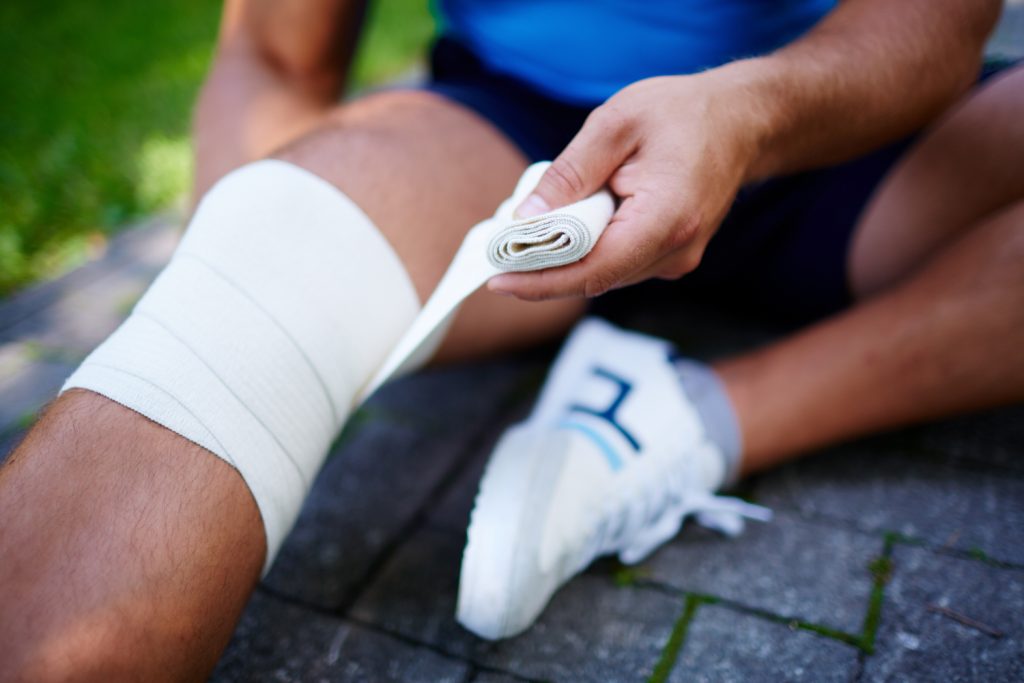During exercise, beginners often experience sports excitement and an emotional high. But in the early stages of training, it is easy to injure yourself by carelessness: injure a muscle, sprain a tendon or even break an arm. Take care of your safety! In this article we will tell you about the features and prevention of sports injuries.
Typical causes of sports injuries
High risk of fractures, sprains, strains, dislocations, and more serious sports injuries are most commonly experienced by soccer players, people who weightlift, hockey players, and runners. Some of the main causes of physical injuries include:
- Use of improperly selected sports equipment.
- Lack of time to conduct a thorough warm-up before sports training.
- Unsuccessful attempts to perform difficult exercises that do not correspond to the level of sports training.
- Exercise against the background of poor health: unstable blood pressure, the first signs of malaise in acute respiratory viral infections.
Strategies for preventing workout injuries
1. Take care of previous injuries
Key features of sports training for people who have suffered previous injuries:
- Be cautious when increasing loads on the injured area.
- Be mindful of the details surrounding the injury. For example, an athlete who injured his knee joint when landing after a jump in basketball should be extremely careful when working with exercises on one leg.

2. Avoid high loads when working with weights
Trainers advise to “avoid high loads at the extremes of joint and spinal motion.” If this advice is ignored, exercise can lead to injury to connective tissues. A great addition to weight training would be a yoga class or a set of flexibility exercises.
3. Do not do difficult tasks when you are fatigued
It has been proven in numerous studies that in a state of fatigue, the effectiveness of sports training is markedly reduced. Muscle tension may be due to biomechanical changes in the response to load.
4. Increase your level of fitness
Increasing your fitness level allows you to better resist overexertion, which reduces the risk of serious injury. A well-designed personal training program provides the optimal sports load on the body without overstressing the body. A training week should include active rest days with low-intensity physical activity.
5. Don’t smoke
The negative effects of smoking on overall health have been proven by scientists. In addition, some scientific studies have found that the habit is a possible risk factor for physical injury. It is also worth refraining from smoking during the recovery period after surgery.
6. Get enough sleep
Getting a good night’s sleep is another measure to reduce sports injuries and increase training productivity. It is recommended that adults get at least 7-8 hours of rest per day. The optimal sleep time for teenage athletes is 9-10 hours.
General recommendations
Beginners in training often make mistakes that can negatively affect their health, from minor sprains and bruises to serious problems that require long-term recovery.
- Have your heart and blood vessels examined
Before beginning strength training, it is recommended that beginners over the age of 40 consult with a general practitioner and cardiologist. This will help to detect the presence of chronic diseases of the cardiovascular system and prevent possible complications.

- Take your time to achieve concrete results
Not everyone can achieve impressive records quickly, but this is normal. If you want to run a fast distance or lift a certain weight, it is important to focus on how you feel and take things step by step. In cases where the body is not ready for intensive exercise, there is a risk of injury due to physical overexertion.
- Warm up diligently and alternate types of exercise
Alternating between different types of exercise will help to avoid overexertion. Do not neglect the combination of strength and cardio training, it is important to pay attention to warming up the joints before going to the gym. For beginners, it is recommended to make a lesson plan with an instructor in order to quickly learn the correct technique of exercises.
- Get plenty of rest between exercises and workouts
One of the most common causes of injury is overtraining. The body, which is not prepared for intensive physical activity, cannot cope well with the load if the beginner takes too short pauses between exercises. The optimal frequency of exercise for non-professional athletes is 2 times a week with two consecutive days off. It is also recommended to take a break from any training for one month a year to give the body time to recover.
- Use the right equipment
When exercising, choose clothing that absorbs moisture quickly and shoes that provide good foot support. Special protective equipment such as elbow pads, kneepads, caps and goggles should be worn for sports with a high risk of injury.
- Adhere to a drinking regime
Observance of a drinking regime for a person engaged in sports is no less important than a balanced diet. It makes ligaments more elastic, prevents heatstroke, and protects the body from dehydration. The optimal amount of fluid intake for one intensive physical training is 600 ml.

How to avoid damages for beginners: trainers’ tips
- Rule No. 1: Warm-up
Warming up before physical activity helps to avoid muscle damage, injuries to shoulder, knee, wrist joints. Warm-up exercises can be done on a special cardio machine. An alternative option to reduce the risk of sports injuries is to perform warm-up exercises yourself. To begin with, you should try to raise your knees as high as possible, do 10-15 squats, then proceed to bending or running in place.
- Rule #2: Start with basic exercises
A person who has recently started going to the gym should not perform technically complex exercises. When working out elements that require experience and skill, you can get sprained ligaments, pinched nerves, sprains. Therefore, before including more difficult exercises in your fitness program, you should master basic sports techniques.
It is recommended to start with exercises that involve several muscle groups at once:
- Deep squats.
- Push-ups from the floor.
- Pull-ups on a bar.
- Exercises to pump the abs.
- Jumping over an obstacle.
Despite the apparent simplicity, simple exercises are quite effective. At the same time, such physical activity will not harm a beginner who has recently started training.
- Rule #3: Choose the optimal activities
A sports training plan is made taking into account individual characteristics such as the athlete’s level of training and general health.
Excessive physical exertion can cause overtraining syndrome, in which the endocrine system suffers. Both of these pathologies are accompanied by a sharp deterioration of well-being: nausea, loss of consciousness, dizziness and other adverse effects.
- Rule #4: Train with adequate weight
One of the possible causes of injuries is the attempt of beginners to take on a weight that is too heavy for them. It is absolutely not recommended to do so. Such rash actions are fraught with serious injuries: protrusions, formation of intervertebral hernias.





